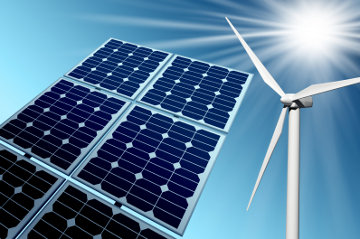Preparing California's power grid for one-third renewable energy by 2020

Renewable energy is variable in nature. Solar and wind power, the two primary ways of creating renewable energy, cannot be created on a steady, constant basis. Thus, the amount of energy they send into the grid is variable. But, our grid currently is poised exactly between supply and demand, so it must stay in equilibrium. This can sometimes be tricky when using steady sources of energy like nuclear, coal, and natural gas. Things get way more complex when renewables are used. "If you knew how complicated it was, you'd be amazed," says V. John White, Executive Director of the Center for Energy Efficiency and Renewables Technologies.
Mike Montoya of SCE details in a slideshow what is needed for a smarter grid:
1) Plug-in electric vehicles that work intelligently with the grid. They will send and receive information on grid load and optimum times to recharge. There are few PEVs on the road now. Within a few years there may be hundreds of thousands of them in urban areas in California, and this will have a significant impact on the grid. We need to be ready for it. Cars that talk to the grid are the answer.
2) Cost-effective energy storage on a grid scale, as well as locally. This is the Holy Grail. We need to store renewable energy for future use. SCE is building an 8 MW battery facility near the in-progress Tehachapi wind farm, which will generate a whopping 4.5 GW when completed. They hope what they learn from this battery facility will help them build even bigger ones. Also, smaller batteries can be installed most anywhere. As an example, a 1 MW battery could be placed on a street corner, storing energy for nearby homes.
3) Open standards for commercial products. Everyone needs to know how everything works and be assured that if they plug their product into something that it will work without software or hardware incompatibilities. I say, take it one step further. Make the software open source.
4) Smart devices everywhere. Home, office buildings, and manufacturing facilities will have devices that will constantly send and receive data about the grid. This will require a massive, secure, and probably wireless telecommunications structure to handle it.
5) Highly skilled workforce. The grid will be mostly controlled by embedded software everywhere that samples power systems 30 times a second and makes decisions based on that. Workers will need the skills to understand and operate it.
It all comes down to stored energy which, if done on a grid-scale, will solve many of the current problems with the grid. Excess wind and solar power would be stored for later use, as would energy from traditional sources. System operators or the embedded software would use that energy as needed. This would eliminate the variability problem of renewable energy. Given that engineers like nothing better than a new challenge, I've no doubt they will figure out how to store energy on a massive scale.




